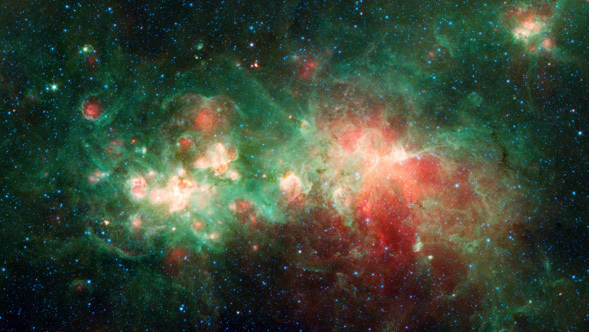
Credit: NASA/JPL-Caltech/GLIMPSE & MIPSGAL Teams
Observation • August 25th, 2020 • ssc2020-14a
ssc2020-14a
The nebula known as W51 is one of the most active star-forming regions in the Milky Way galaxy. First identified in 1958 by radio telescopes, it makes a rich cosmic tapestry in this image from NASA's recently retired Spitzer Space Telescope.
Located about 17,000 light-years from Earth, in the direction of the constellation Aquila in the night sky, W51 is about 350 light-years - or about 2 quadrillion miles - across. It is almost invisible to telescopes that collect visible light (the kind human eyes detect), because that light is blocked by interstellar dust clouds that lie between W51 and Earth. But longer wavelengths of light, including radio and infrared, can pass unencumbered through the dust. When viewed in infrared by Spitzer, W51 is a spectacular sight: Its total infrared emission is the equivalent of 20 million Suns.
About the Object
- Name
- W51
- Type
- Nebula > Type > Star Formation
- Distance
- 17,000 Light Years
Color Mapping
| Band | Wavelength | Telescope |
| Infrared | 3.6 µm | Spitzer IRAC |
| Infrared | 4.5 µm | Spitzer IRAC |
| Infrared | 8.0 µm | Spitzer IRAC |
| Infrared | 24.0 µm | Spitzer MIPS |
Astrometrics
- Position ()
- RA =19h 19m 26.0s
- Dec = 13° 22' 39.2"
- Field of View
- 2.0 x 1.3 degrees
- Orientation
- North is 298.0° right of vertical





